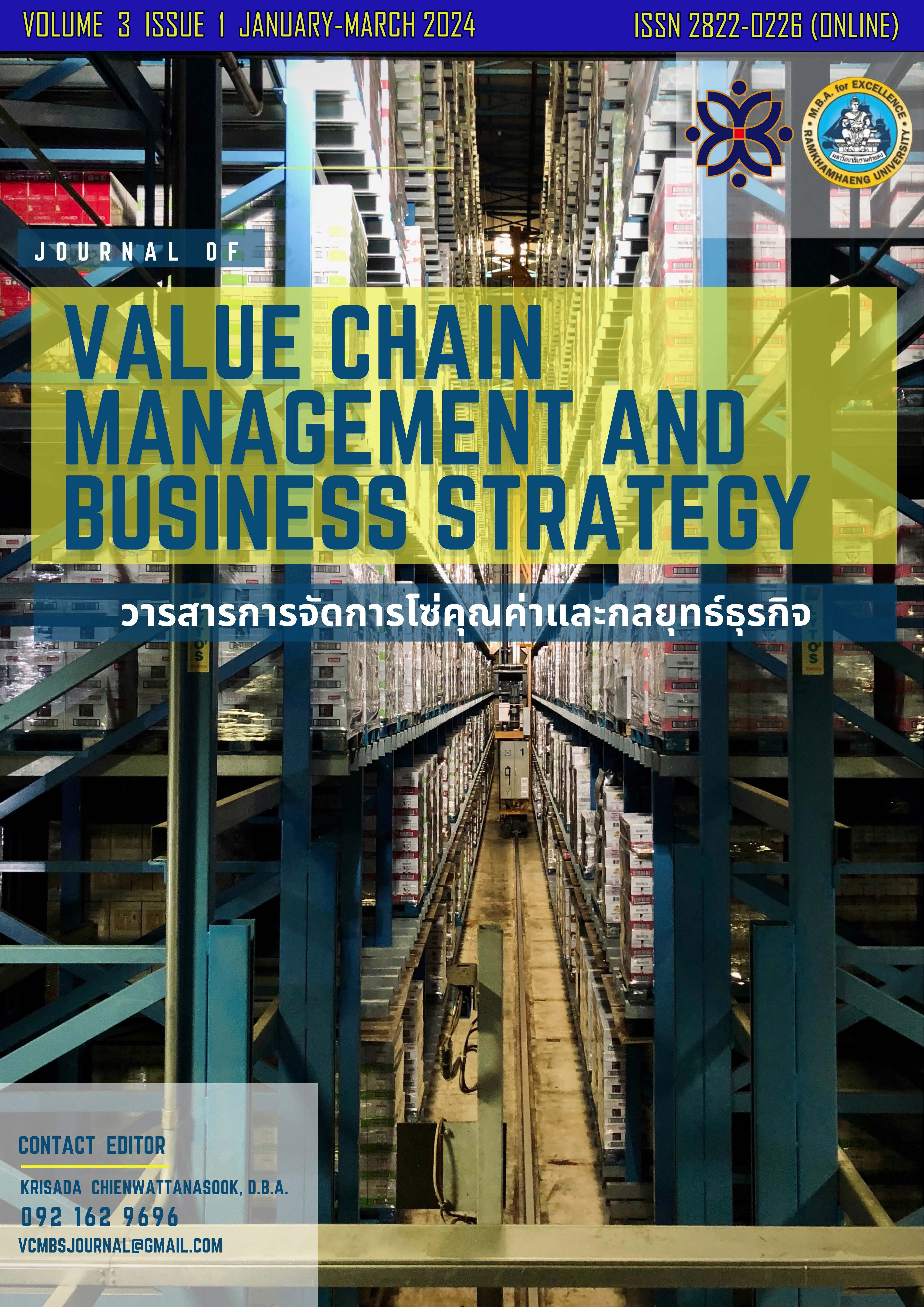ความสัมพันธ์ระหว่างภาวะผู้นำของผู้บริหารกับประสิทธิภาพการทำงานที่มีคุณภาพของบุคลากรในกรมสรรพสามิตประเทศไทย
คำสำคัญ:
ภาวะผู้นำ , ประสิทธิภาพการทำงาน , กรมสรรพสามิตประเทศไทยบทคัดย่อ
การวิจัยนี้มีวัตถุประสงค์เพื่อศึกษาปัจจัยส่วนบุคคลที่ส่งผลต่อประสิทธิภาพการทำงานที่มีคุณภาพของบุคลากรในกรมสรรพสามิตประเทศไทย และเพื่อศึกษาภาวะผู้นำของผู้บริหารที่มีความสัมพันธ์กับประสิทธิภาพการทำงานที่มีคุณภาพของบุคคลากรในกรมสรรพสามิตประเทศไทย กลุ่มตัวอย่างที่ใช้ในการวิจัย คือ บุคลากรในกรมสรรพสามิตประเทศไทย จำนวน 400 ตัวอย่าง ด้วยวิธีการสุ่มตัวอย่างแบบตามสะดวก โดยใช้แบบสอบถามเป็นเครื่องมือในการเก็บรวบรวมข้อมูล วิเคราะห์ข้อมูลด้วย ค่าความถี่ ร้อยละ ค่าเฉลี่ย ส่วนเบี่ยงเบนมาตรฐาน และทดสอบสมมติฐาน ได้แก่ การทดสอบแบบที การวิเคราะห์ความแปรปรวนทางเดียว และการวิเคราะห์สหสัมพันธ์เพียร์สัน
ผลการวิจัยพบว่า ปัจจัยส่วนบุคคล ได้แก่ เพศ อายุ และสถานภาพ ที่แตกต่างกันส่งผลต่อประสิทธิภาพการทำงานที่มีคุณภาพของบุคลากรในกรมสรรพสามิตประเทศไทยแตกต่างกัน อย่างมีนัยสำคัญทางสถิติที่ระดับ 0.05 และภาวะผู้นำของผู้บริหาร ได้แก่ ด้านการแสดงตนเป็นแบบอย่างในการปฏิบัติ ด้านการสร้างแรงบันดาลใจในการมีวิสัยทัศน์ร่วมกัน ด้านการท้าทายกระบวนการทำงาน ด้านการมอบอำนาจให้ผู้อื่นสามารถปฏิบัติงานแทน และด้านการเสริมสร้างกำลังใจ มีความสัมพันธ์กับประสิทธิภาพการทำงานที่มีคุณภาพของบุคลากรในกรมสรรพสามิตประเทศไทย อย่างมีนัยสำคัญทางสถิติที่ระดับ 0.05
เอกสารอ้างอิง
กรมสรรพสามิต. (2564). บทสรุปผู้บริหารแผนการพัฒนาดิจิทัลของกรมสรรพสามิต. https://www.excise.go.th/cs/groups/public/documents/document/dwnt/ndgw/~edisp/uatucm480462.pdf
กรมสรรพสามิต. (2566). ประวัติความเป็นมาของกรมสรรพสามิต. https://www.excise.go.th/excise2017/ABOUT_US/HISTORY/index.htm
กรมสรรพสามิต. (2566). วิสัยทัศน์ พันธกิจ ยุทธศาสตร์กรมสรรพสามิต. https://www.excise.go.th/excise2017/ABOUT_US/VISION/index.htm
จุรีวรรณ จันพลา และหทัยกานต์ กุลวชิราวรรณ์. (2565). ปัจจัยที่ส่งผลต่อประสิทธิผลการทำงานที่บ้านของพนักงานในจังหวัดนครปฐมในช่วงวิกฤตโควิด-19. วารสารมนุษยศาสตร์และสังคมศาสตร์ มหาวิทยาลัยนครพนม, 12(3), 44-61.
ธีรวัฒน์ วงศ์วรัญญู. (2563). ผลกระทบของระบบอุปถัมภ์ในหน่วยงานราชการต่อการปฏิบัติหน้าที่ของข้าราชการในจังหวัดเลย. วารสารวิจัยและพัฒนา มหาวิทยาลัยราชภัฏเลย, 15(54), 65-75.
นฤมล เพ็ญสิริวรรณ. (2561). ภาวะผู้กับการพัฒนาองค์กรให้มีประสิทธิภาพสูงสุด. วารสาร มจร มนุษยศาสตร์ปริทรรศน์, 4(2), 117-125.
ประทีป แสงแพร, ทองฟู ศิริวงศ์ และสมพล ทุ่งหว้า. (2562). ภาวะผู้นำมีความสัมพันธ์กับประสิทธิภาพในการทำงานของพนักงาน กรณีศึกษาธนาคารพาณิชย์ไทยแห่งหนึ่งในเขตสาทร. วารสารนักบริหาร, 10(2), 66-83.
ภักดี มะนะเวศ. (2563). ปัจจัยส่วนบุคคล ความผูกพันต่อองค์กร และประสิทธิภาพการทำงานขององค์กร. วารสารปาริชาต มหาวิทยาลัยทักษิณ, 33(1), 17-28.
สถิติบุคลากรกรมสรรพสามิต. (2565). จำนวนบุคลากรกรมสรรพสามิต. https://www.excise.go.th/hrm/HR_REPORT/STATIC_HR/index.htm
สำนักงานคณะกรรมการข้าราชการพลเรือน. (2566). ระบบบริหารราชการของราชอาณาจักรไทย. https://www.ocsc.go.th/sites/default/files/document/thailand.pdf
Avolio, B. J., & Gardner, W. L. (2018). Authentic leadership development: Getting to the root of positive forms of leadership. The Leadership Quarterly, 29(3), 316-336.
Avolio, B. J., Gardner, W. L., Walumbwa, F. O., & Reichard, R. J. (2009). Authentic leadership: A review of the literature and research agenda. The Leadership Quarterly, 20(3), 427-448.
Bass, B. M. (2010). Transformational leadership: An overview. In J. R. Meindl & C. Stubbart (Eds.), The Oxford handbook of leadership (pp. 171-197). Oxford University Press.
Bass, B. M., & Riggio, R. E. (2012). Transformational leadership. Psychology Press.
Blanchard, K. (2016). Situational leadership theory. In S. R. Clegg, C. Hardy, T. B. Lawrence, & W. R. Nord (Eds.), The SAGE handbook of leadership (2nd ed.). SAGE Publications Ltd.
Cherry, K. (2021). Behavioral theories of leadership. Verywell Mind. https://www.verywellmind.com/leadership-behavioral-theories-2795316
Coltman, E. (2019). Why leadership matters in business management. Forbes.
Hsieh, J.-C., & Phakthongsuk, S. (2019). Leadership and Organizational Performance: A Study of Large Corporations in the United States. Journal of Leadership, Accountability and Ethics, 16(2), 60–71.
Hunt, S. (2018). Incentives, Motivation and Workplace Performance: Research & Best Practices. Strategic HR Review, 17(5), 221-226.
Judge, T. A., & Piccolo, R. F. (2012). Transformational and transactional leadership: A meta-analytic test of their relative validity. Journal of Applied Psychology, 97(3), 546-556.
Kouzes, J. M., & Posner, B. Z. (1987). The leadership challenge: How to get extraordinary things done in organizations. Jossey-Bass.
Northouse, P. G. (2012). Leadership: Theory and practice. Sage.
Northouse, P. G. (2018). Trait theory of leadership. In Leadership: Theory and practice (8th ed.). SAGE Publications, Inc.
Peterson, J. B., & Plowman, D. A. (2003). Performance outcomes and their antecedents in the service organization: The case of the contingent workforce. Journal of Management, 29(5), 607-628.
Peterson, J. B., & Plowman, D. A. (2009). Macro and micro level tensions in performance measurement. Organization Studies, 30(1), 117-141.
Robbins, S. P., & Coulter, M. (2017). Management (13th ed.). Pearson.
Rodríguez Escudero, A. I., & Ficapal-Cusí, P. (2019). Human Resources Management: The Importance of Knowledge Transfer. Journal of Knowledge Management, 23(3), 522–536.
Saxena, R. P. (2013). The importance of leadership in management. Journal of Contemporary Research in Management, 8(2), 49-53.
Treviño, L. K., Weaver, G. R., & Gibson, D. G. (2017). Ethical leadership. Routledge.
Yamane, T. (1973). Statistics an introductory analysis (3rd ed.). Harper and Row.
ดาวน์โหลด
เผยแพร่แล้ว
รูปแบบการอ้างอิง
ฉบับ
ประเภทบทความ
สัญญาอนุญาต
ลิขสิทธิ์ (c) 2024 วารสารการจัดการโซ่คุณค่าและกลยุทธ์ธุรกิจ

อนุญาตภายใต้เงื่อนไข Creative Commons Attribution-NonCommercial-NoDerivatives 4.0 International License.




